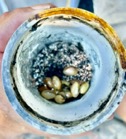Freshwater Mussels - The Big Reveal
- Mary Ward Kuramoto
- Nov 15, 2022
- 3 min read

Recently a team of volunteers and staff from the Little Miami Conservancy (LMC) and local conservation groups, with support from noted research scientists, wrapped up a yearlong collaborative effort seeking to determine if decreasing populations of freshwater mussels can be restored in the Little Miami State and National Scenic River. This important project was partially funded through Ohio Department of Natural Resources Conservation grants and undertaken with the help of a legion of volunteers and national freshwater mussel experts who graciously donated their time and effort to make it happen.
The team's efforts over the past 12 months were well documented, from analyzing the issues surrounding the decline of freshwater mussels beneath the surface of the Little Miami State and National Scenic River, to collaboration with freshwater mussel experts, and lastly, deployment of mussel silos with juvenile mussels for 3 months. In September, the silos were retrieved and the initial results for the team are promising.
The Big Reveal
One of the most difficult issues the team faced after months of planning,
preparation, and mussel deployment was waiting 90 days to learn if the juvenile
mussels survived and grew. So with a bit of trepidation and excitement, the crews including Wendell Haag, Ph.D, U.S. Forest Service and Center for
Conservation of Mollusks in Frankfort Ky, embarked on the retrieval stage in late September. Not only did the retrieval crews have to find and retrieve the silos, but they also collected and photographed the silos and the mussels, along with retrieving thermologger buttons that recorded water temperature.
The team recorded their first hand observations as to the health and condition of the
deployed mussels, and then bagged, marked, and froze the mussels in separate zip lock bags for additional study and analysis in the laboratory.
Initial Observations and Best Practices for Site Selections Going Forward
Optimum conditions for juvenile freshwater mussels to grow in the test silos is
based on appropriate river locations that provide suitable habitat including good river flow, stable substrate, presence of native fish species, and a host of other features. Site selection is also predicated on selecting locations where the silos will not be easily spotted and investigated by the general public -recreational users enjoying the rivers who regularly fish or paddle the Little Miami. To our credit and that of the general public, all 29 silos deployed were retrieved in good shape. Only one of the sites experienced an issue where all three silos were found high and dry. This was likely due to human interference. Two of the three silos still had mussels inside - having shown initial growth - however they died when pulled from the water.
Overall, there was progressive variation in the amount of mussel growth. The growth showed a consistent pattern. Downstream sites progressively produced the most growth and survival. Upstream sites had cooler water temperatures and produced less mussel growth than sites farther downstream where higher water temps revealed larger growth patterns. Water temperature is a known factor contributing to mussel growth. Drainage area, stream gradient, fish diversity, high levels of dissolved oxygen, and stable water flow are also factors that contribute to survival of freshwater mussels.
What’s Next for this Project?
Further lab analysis on the mussel specimens retrieved will be completed, looking for toxins and other possible causes of declining numbers among mussel populations. Results from the lab analysis along with continued mussel silo deployments could determine if conditions in the Little Miami State and National Scenic River can sustain freshwater mussels and support re-introductions of new juvenile mussels native to the Little Miami.
This project is not at an end. In Spring 2023, the crews will hit the Little Miami once
more, equipped with the knowledge from the 2022 mussel deployment.
While we are all encouraged that the freshwater mussel project moves forward into another year, there is an added value to the project beyond the mussel movement. The group saw a great collaboration and cooperation taking place between scientific experts in their field and other conservation groups as well as government funding in terms of conservation grants.
Learn more about the project:

Our Thanks and Acknowledgement
This project could only be completed with the help of many experts and volunteers who have given generously their time and knowledge. Much credit goes out to the experts for their generous consultation, published knowledge, and passion for this research.
Among them are Monte McGregor, Ph.D, and the Center for Conservation of Mollusks in Frankfort, Kentucky; Wendell Haag, Ph.D, U.S. Forest Service; Michael Hoggarth, Ph.D, Otterbein University, Trisha Gibson, Ohio State University Freshwater Mussel Conservation and Research Center, Columbus, Ohio and Chris Barnhart, Ph.D Missouri State University.
Encouragement and support was also provided by the Ohio Department of Natural Resources.
.jpeg)







Comments